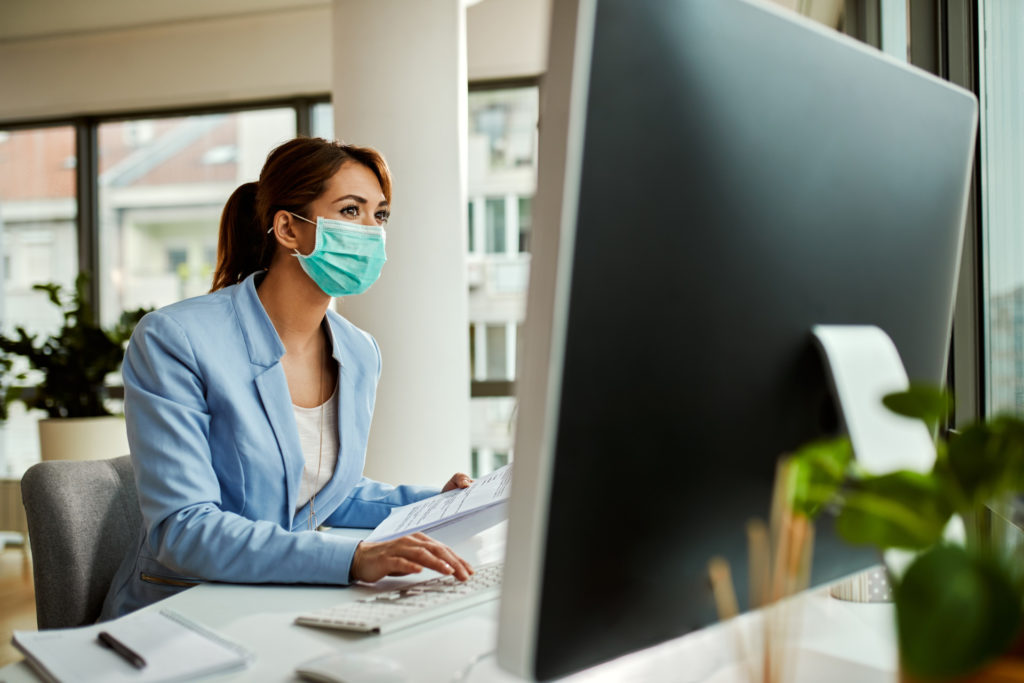Returning to work post COVID-19
AgriLife Extension offers tips for alleviating concerns, stresses as businesses open
Returning to work after six weeks under the COVID-19 pandemic shutdown can cause differing amounts of emotions – disbelief, fear and even anger – among workers, much like after a disaster.

But employers and co-workers alike can watch for signs of emotional impact over the coming weeks and months, to ensure everyone is finding their way back to a new normal, said a Texas A&M AgriLife Extension Service specialist.
When states, cities and workplaces begin reopening, COVID-19 won’t be gone, nor will the concerns that surround it, said Miquela Smith, AgriLife Extension health specialist, Amarillo.
Some workers will gladly head back to their offices and places of business, while others will do so with trepidation, Smith said.
Returning to work
Many Americans with management and professional occupations will be able to continue working from home, while those with service, production and maintenance-related jobs will have to physically return to work, she said. Employees who can continue to work from home will inherently be at a lower risk of exposure to the virus compared to those who cannot.
This will disproportionately affect Americans with lower education levels because they are less likely to occupy professional and management positions that might allow them to work from home, Smith said.
“Minimizing employees’ potential exposure to COVID-19 must be a top priority,” she said. “The CDC offers resources on their website for businesses and employers to help them prepare to safely reopen. Reopening businesses will come with challenges and people will respond differently to being back at work.”
Some people may have lost loved ones or know someone who got sick, so it will hit close to home, Smith said. Others may have anxiety about returning to work safely; or about finding safe daycare for their children, who are not returning to school. Others will be tired of being at home and will welcome the opportunity to go about life as if nothing is happening.
“Each of our lives have been altered and directly impacted by this crisis,” she said. “Crisis situations affect people differently and just because a person is not responding to the pandemic in the way you think they should, does not mean they are unaffected. Returning to work after a pandemic is new territory for all of us, and we must have patience with ourselves and others while we navigate the process.”
Emotional stress and well-being
Employers and co-workers should watch for signs of emotional impact over the coming weeks and months. Signs someone may be struggling in their return to the workplace include changes in performance and productivity, such as missing deadlines, calling in sick frequently, absenteeism, irritability and anger, difficulty concentrating and making decisions, withdrawal from work activity, and difficulty with work transitions or changes in routines.
Smith suggested employers will need to educate supervisors and managers to be aware of the signs of emotional distress, and to encourage staff to seek treatment when necessary. One program that is offered by AgriLife Extension, Mental Health First Aid, teaches these exact skills. That program is in the process of being modified so it may be offered on a fully virtual platform soon.
“While each business will dictate how they come back online and what will be expected of their employees, it is important to remind them that support among colleagues can help employees work through difficulties,” she said.
Initially, it may also be important to reconsider travel needs, as employees, clients and other individuals may be hesitant to make business trips for some time. Consider postponing or canceling upcoming conferences and other meetings that require travel.
Do’s and don’ts upon returning to work
Key messages Smith offered for individuals to help facilitate a safe return to the workplace include:
- Wash your hands often with soap and water for at least 20 seconds. Use hand sanitizer with at least 60% alcohol if soap and water are not available
- Avoid touching your eyes, nose and mouth with unwashed hands.
- Follow the policies and procedures of your employer related to illness, cleaning and disinfecting, work meetings and travel. Continue to follow guidelines from state and local authorities for using face coverings in public spaces.
- Clean and disinfect frequently touched objects and surfaces in your work area, including keyboards, phones, handrails and doorknobs.
- Stay home if you are sick, except to get medical care.
- Inform your supervisor if you have a sick family member at home with COVID-19.
- Avoid using other employees’ phones, desks, offices, or other work tools and equipment, when possible. If necessary, clean and disinfect them before and after use.
- Know what to expect of yourself. You may experience a variety of emotions after returning to work, which is normal. Talking about your feelings with someone you trust is a healthy way to process this evolving situation.
- Continue to take care of yourself. Eat well, get plenty of rest and exercise, spend time with those closest to you.
- Take care of your children and your family. Parents could be concerned about their children’s well-being when they must return to work. Make sure your children know proper hygiene practices and let them talk about what is going on to help reassure them.
- Seek help if you need to. If your feelings are too much to bear, seeking help is a sign of strength, not weakness. Mental health problems—in general and in response to a major event such as the pandemic—are real, diagnosable and treatable.
- Know your rights and the COVID-19-related guidance that has been given for your specific industry by visiting the CDC website and the Occupational Safety and Health Administration website.


